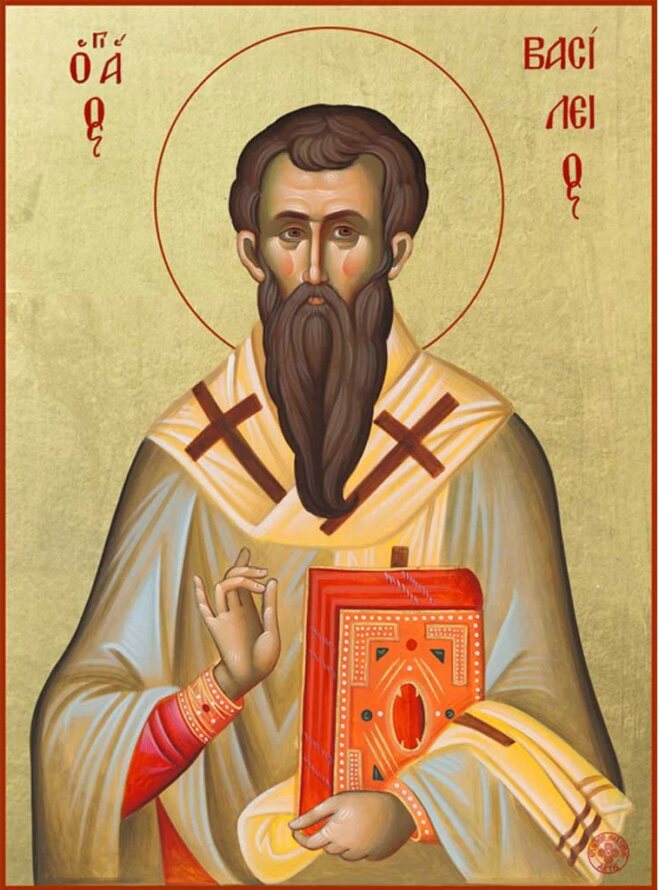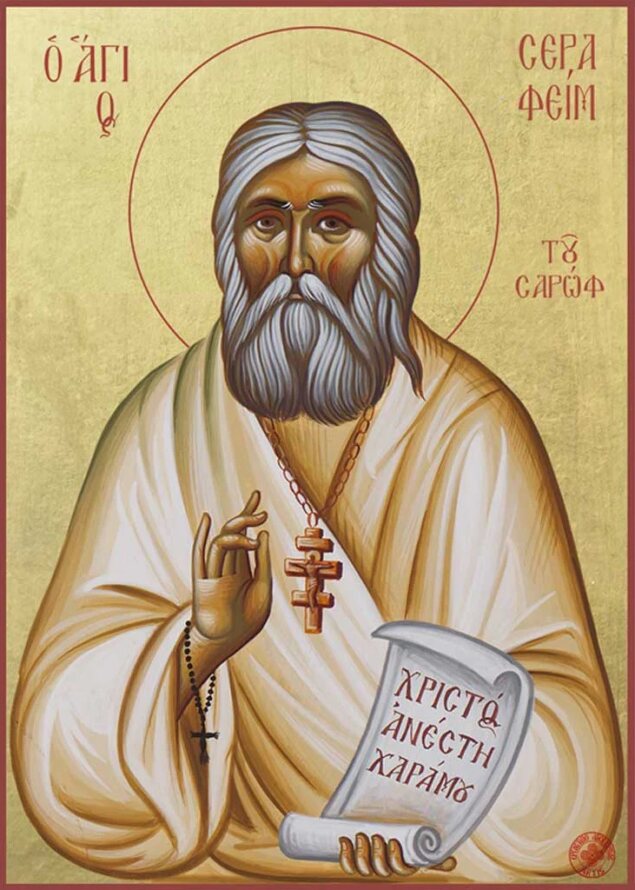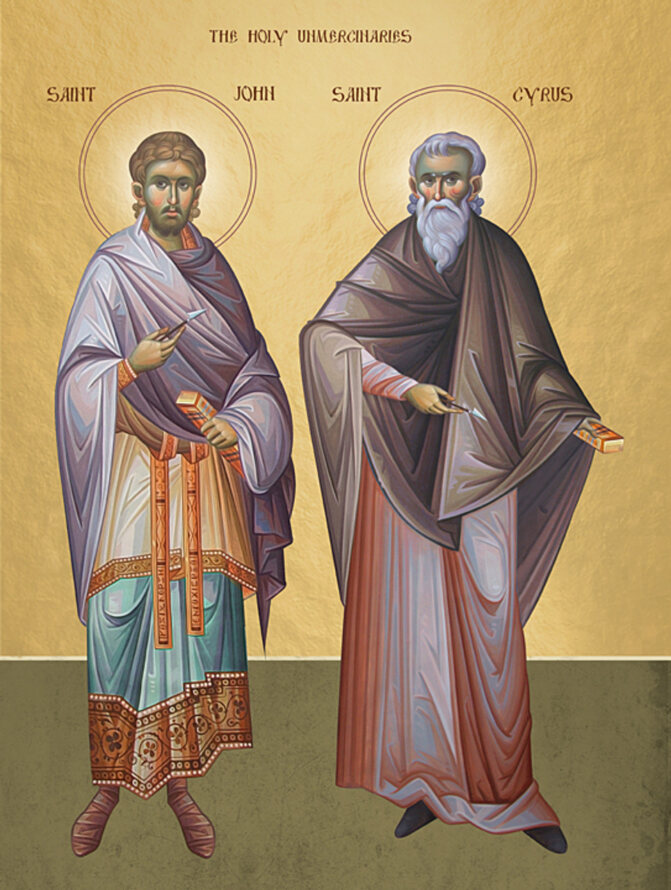All the saints in the calendar of the Orthodox Church are models and intercessors to God for Christians and help them find solutions to the problems they encounter. Certain saints stand out for their help in healing physical and spiritual illnesses.
In 2024, a year designated by the Holy Synod of the Romanian Orthodox Church for the observance of all unmercenary saints, every month, we will highlight the saints renowned for their healing abilities or capacity to endure the cross of illness.
To start with, we have selected eight holy healers celebrated in January.
St Basil the Great (January 1)

Saint Basil the Great is one of the most renowned Church Fathers of the 4th century. He was born into a distinguished and faithful family, which gave the world eight saints. The education his family gave him led him both to deepen his knowledge and to cultivate virtues.
His studies in Athens, along with his friend St Gregory the Theologian, included philosophy, astronomy, mathematics, and medicine. He later used this knowledge to help the sick.
St Basil founded a charitable institution near Caesarea, later known as the “Vasiliada”. Around a church, guest houses, hospitals, infirmaries, and leproseries were erected. The Synaxaria mention that the saint sometimes cared for the lepers and did not hesitate to embrace them.
Exhausted by illness, ascetic life, and episcopal responsibilities, St Basil reposed in the Lord at the age of 49.
Saint Basil the Great is celebrated on January 1, the same day as his mother, St Emilia. A few days later, on January 9 and 10, his brothers St Peter, Bishop of Sebaste and St Gregory, Bishop of Nyssa, are celebrated.
St Seraphim of Sarov (January 2)

Saint Seraphim of Sarov enlightened the Church with his love and outstanding gentleness in the 18th century.
The son of pious merchants in the city of Kursk, Russia, the saint followed the monastic path from his youth. In his early years as a monk, after falling seriously ill and refusing medical help, he asked for only one medicine: the Holy Eucharist. After that, the Mother of God and Saints Peter and John appeared to him, healing him completely.
After this event, the young novice collected money from the neighbouring villages and built an infirmary on the spot where the Mother of God had appeared to him.
Later, after many years of ascetic life and trials, he healed the sick who came to him. He would anoint them with oil from the candle that burned in his cell or give them water from the spring, later called “the spring of St. Seraphim,” near the Sarov monastery.
His relics performed many miracles when he was canonised on July 19, 1903. After they were lost following the installation of the Communist regime, they were rediscovered in the Museum of Atheism in St Petersburg.
St Nikephoros the Leper (January 4)

Nikephoros the Leper is a contemporary saint born in Greece in 1890 and reposed in the Lord in 1964.
He was afflicted with leprosy at the age of 13, and to avoid being admitted to a leprosarium, he went to Alexandria, Egypt, where the Greek community welcomed him. When he could no longer hide the signs of the disease, a bishop sent him back to Greece, to the leprosarium in Chios, run by St Anthimos, himself afflicted with the disease.
He was tonsured a monk and advanced on the path of virtue there. After the closure of the leprosarium in 1957, Venerable Nikephoros arrived at St. Barbara’s Hospital for Infectious Diseases in Athens. God gave him spiritual gifts for his patience in sickness, through which he brought consolation and hope to the sick in the hospital. Famous bishops and confessors came to ask for his advice at the hospital, which had been transformed into an “antechamber of Heaven”.
During his time in Athens, he had as disciple another saint, Elder Eumenios Saridakis, who had recovered from leprosy.
St Nikephoros gained increasing popularity during the coronavirus pandemic in 2020.
St Nino, enlightener of Georgia (January 14)

Saint Nino was born in Cappadocia towards the end of the 3rd century. Raised in a devout family, she had a special calling from a young age from the Mother of God, who entrusted her with Christening Iberia, present-day Georgia.
As a sign of her protection, the Mother of God gave her a grapevine cross.
Saint Nino later used this cross to heal the queen of Iberia, Nana, of an incurable disease. The saint refused compensation, saying that this miracle was not her merit but the work of Christ.
The sick were fully healed through her prayers, and a wonderful spring was formed from her tears, giving milk to mothers who lacked it.
Thus, her many miracles and healings convinced the pagans to receive Christian baptism and contributed to the achievement of her mission.
Saint Nino was the only daughter of General Zebulon, the godfather of the Great Martyr George.
St Anthony the Great (January 17)

Around the age of twenty, the saint renounced the worldly life after hearing the words of the Gospel: “If you want to be perfect, go, sell what you have and give to the poor, and you will have treasure in heaven; and come, follow Me” (Matthew 19:21).
He followed the “narrow path,” paved with many trials and temptations from the enemy, which refined him and transformed him into a true spiritual father, making many monks come to take his counsel.
It is mentioned in his life that Saint Anthony had the power to heal diseases through prayer. He prayed for those who came to him asking for healing of physical illnesses, considering them as his own infirmities.
When God brought healing through his intercession, the saint gave glory to God. If the Lord did not answer his prayers, he gave thanks anyway and encouraged the sick not to lose hope.
The life of St Anthony was written by his disciple, St Athanasius the Great.
St Xenia of Petersburg (January 24)

Saint Xenia lived as a “fool for Christ” during the seventeenth century. Similar to the Saviour Christ, she abandoned all temporal comforts following the death of her spouse and resolved to wander barefoot through the impoverished neighbourhoods of St Petersburg, wearing tattered clothing throughout the seasons and having no roof over her head.
However, she was constantly accompanied by God, and He conducted numerous miracles through her. The day’s revenue increased upon the saint’s entrance into a store. Upon receiving her embrace, an ill child recovered.
Presently, numerous believers hold St. Xenia in high regard for her expeditious assistance in resolving contemporary challenges and alleviating physical anguish. To seek solace, believers visit her tomb in the Smolensk Cemetery (St. Petersburg), where they take candle oil or soil as a blessing.
Saint Xenia is renowned for her assistance with family formation and employment.
Sts Cyrus and John (January 31)

Listed among the unmercenary saints, Saints Cyrus and John lived during the rule of Emperor Diocletian in the 2nd and 3rd centuries.
Saint Cyrus was a physician by profession, but he also healed the sick with prayer and preaching the word of God. St John was a soldier, but after meeting St. Cyrus, he became his disciple.
They confessed Christ before the pagan governor of Syria, who ordered their heads to be cut off.
In the 7th century, St. Sophronius of Jerusalem was cured of an eye disease after the two saints appeared to him: St. Cyrus healed one eye with the sign of the Holy Cross, and immediately afterwards, St. John restored his sight entirely by kissing the other eye.
St. Sophronius wrote a lengthy account of their miracles as an act of gratitude.
View this post on Instagram
Bibliography: Sinaxarion, Lives of the Saints, Vol. 5, January, Ed. St. John Cassian, Bucharest, 2015






